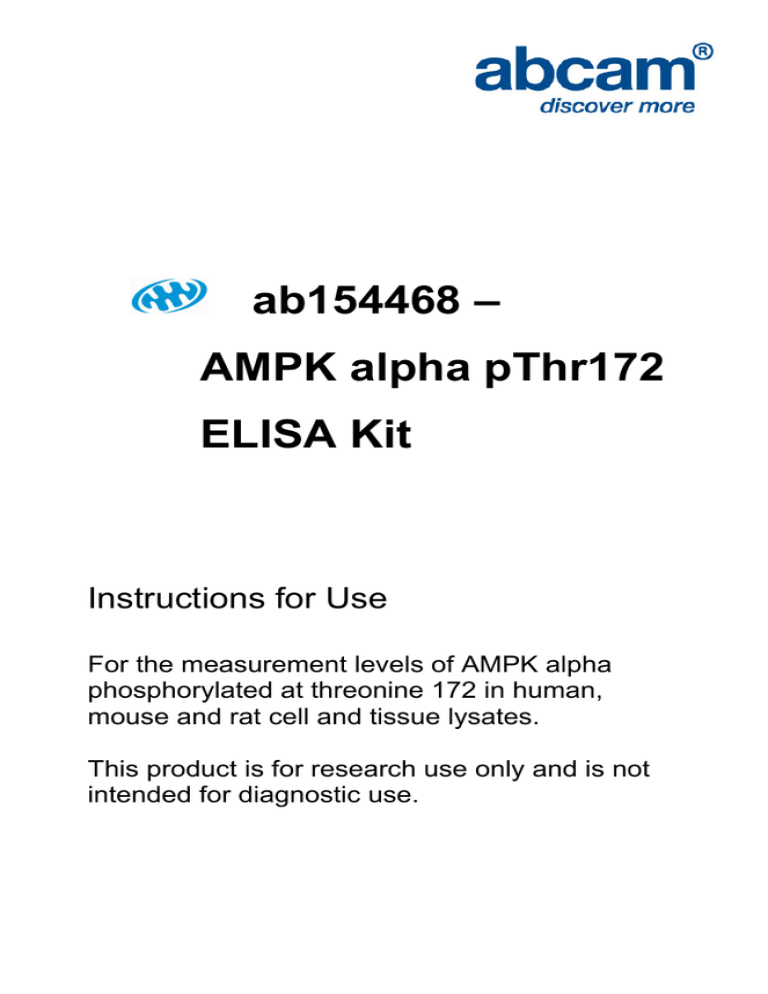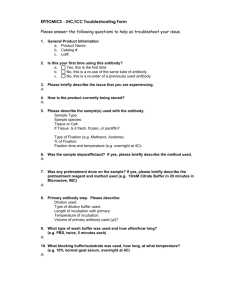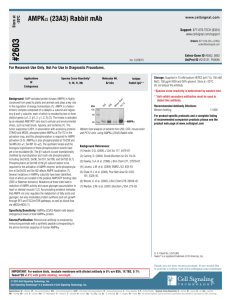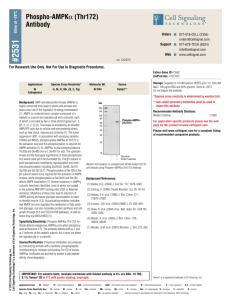ab154468 – AMPK alpha pThr172 ELISA Kit Instructions for Use
advertisement

ab154468 – AMPK alpha pThr172 ELISA Kit Instructions for Use For the measurement levels of AMPK alpha phosphorylated at threonine 172 in human, mouse and rat cell and tissue lysates. This product is for research use only and is not intended for diagnostic use. Table of Contents 1. Introduction 2 2. Assay Summary 5 3. Kit Contents 6 4. Storage and Handling 6 5. Additional Materials Required 7 6. Preparation of Reagents 8 7. Sample Preparation 9 8. Assay Procedure 12 9. Data Analysis 14 10. Specificity 18 11. Cross-reactivity 21 11. Troubleshooting 22 1 1. Introduction Principle: ab154468 5'-AMP-activated protein kinase catalytic subunit alpha (AMPKα1, PRKAA1) phospho T172 ELISA (EnzymeLinked Immunosorbent Assay) kit is an in-vitro enzyme-linked immunosorbent assay for the accurate measurement of AMPK α phospho T172 in human, rat and mouse lysates. The assay employs a specific mouse monoclonal antibody bound to the plate. Standards and samples are pipetted into the wells in conjunction with a rabbit monoclonal primary detector antibody. After washing away excess protein and unbound detector antibody, an HRPconjugated secondary detector antibody (HRP Label) specific for the primary detector antibody is pipetted to the wells. The wells are again washed, a TMB substrate solution is added to the wells and color develops in proportion to the amount of AMPKα pT172 bound. The developing blue color is measured at 600 nm. Optionally, the reaction can be stopped by adding hydrochloric acid which changes the color from blue to yellow and the intensity can be measured at 450 nm. 2 Background: AMP-activated protein kinase (AMPK) is an energy sensor protein kinase that plays a key role in regulating cellular energy homeostasis. Mammalian AMPK is a heterotrimer kinase, containing a catalytic subunit (α) and two regulatory subunits (β and γ). Each subunit has different isoforms (α1, α2, β1, β2, γ1, γ2, γ3) with differential tissue expression, cellular localization and functionality. Human AMPK has a 98.7% sequence similarity with mouse AMPK and a 99% sequence similarity with rat AMPK. It has been hypothesized that when ADP or AMP are present at high levels, these nucleotides bind directly to the γ subunit, leading to a conformational change that allows phosphorylation of Thr172 at the α subunit. Phosphorylation of AMPK α activates the kinase, which leads to downstream effects concerted to increase catabolic pathways and suppress anabolic pathways in order to restore levels of cellular ATP and ultimately control cell fate. AMPK is activated physiologically due to stresses such as low nutrients and prolonged exercise. activated pharmacologically by Furthermore AMPK may be metformin (the most widely prescribed Type 2 diabetes drug), phenformin, AICAR and resveratrol. Activation of AMPK due to low nutrients leads to suppression of the mammalian target of rapamycin complex 1 (mTORC1) pathway allowing coordination and control of cell growth and autophagy. Furthermore, AMPK also controls metabolism via direct phosphorylation of metabolic enzymes such as Acetyl-CoA carboxylase (ACC1 and ACC2) HMG-CoA reductase, hormone 3 sensitive lipase (HSL), adipose triglyceride lipase (ATGL), Insulin receptor substrate 1 (IRS1) and phosphofructo-kinase (PFKFB). Control of metabolism also occurs long term through control of transcription and chromatin structure via phosphorylation of transcription factors (SREBP1, PPARγ), co-activators (CRTC family, PGC1α), acetyltransferase p300, histone H2B and histone deacetylases (HDACs class IIa). Activation of AMPK has also been linked to circadian clock regulation via phosphorylation of Cry1, coupling daily light and dark cycles to the metabolic control of fed and fasting cycles. In addition, it has been suggested that AMPK may control cell polarity and cytoskeletal dynamics in some settings. 4 2. Assay Summary Equilibrate all reagents to room temperature. Prepare all the reagents, samples, and standards as instructed. Add 25 µL of 2X sample to each well used and overlay with 25 µL of 2X detector antibody. Incubate 3 hours at room temperature. Aspirate and wash each well three times. Add 50 μL of prepared HRP labeled secondary detector antibody. Incubate 1 hour at room temperature. Aspirate and wash each well four times. Add 100 μL TMB Development Solution to each well. Immediately begin recording the color development with elapsed time at 600 nm for 15 minutes. Alternatively add 100 μL of a Stop solution (1N HCl) at a user-defined time and read at 450 nm. 5 3. Kit Contents Item Quantity 10X Wash Buffer 40 mL Extraction Buffer 15 mL 10X Blocking Buffer 6 mL TMB Development Solution 12 mL 20X AMPK alpha pT172 Detector Antibody 250 µL 10X HRP Label AMPK α Microplate 1 mL 96 Wells 4. Storage and Handling Store all components at 4°C (do not freeze the lyophilized protein). This kit is stable for 6 months from receipt. Unused microplate strips should be returned to the pouch containing the desiccant and resealed. 6 5. Additional Materials Required Microplate reader capable of measuring absorbance at 600 nm (or 450 nm after addition of Stop Solution - not supplied. Method for determining protein concentration (BCA assay recommended). Deionized water Multi and single channel pipettes PBS (1.4 mM KH2PO4, 8 mM Na2HPO4, 140 mM NaCl, 2.7 mM KCl, pH 7.3) Tubes for standard dilution Stop Solution (optional) – 1N hydrochloric acid Optional plate shaker for all incubation steps Well plate cover or seals 7 6. Preparation of Reagents 6.1 Equilibrate all reagents to room temperature (18-25°C) prior to use. 6.2 Prepare 1X Wash Buffer by adding 40 mL of 10X Wash Buffer to 360 mL of nanopure water. 6.3 Prepare 1X Incubation Buffer by adding 6 mL of 10X Blocking Buffer to 54 mL of 1X Wash Buffer. Excess unused 1X Incubation buffer may be stored at -20°C for 6 months after performing the ELISA. 6.4 Prepare 2X AMPK alpha pT172 primary detector antibody with 1X Incubation Buffer immediately prior to use, by diluting the supplied stock 10 fold. Prepare 250 µL for each 8 well strip used. 6.5 Prepare 1X HRP labeled secondary antibody by diluting the supplied stock 10-fold with 1X Incubation Buffer immediately before use. Prepare 500 µL for each 8 well strip used. 8 7. Sample Preparation Note: The extraction buffer provided with this kit may be supplemented with phosphatase inhibitors, PMSF and protease inhibitor cocktail prior to use. Supplements should be used according to manufacturer’s instructions. 7.1 Preparation of extract from cell pellets (Human, mouse, rat). 7.1.1 Collect non adherent cells by centrifugation or scrape to collect adherent cells from the culture flask. Typical centrifugation conditions for cells are 500 x g for 10 min at 4°C. 7.1.2 Rinse cells twice with PBS. 7.1.3 Solubilize cell pellet at 4x107/mL in Extraction Buffer. 7.1.4 Incubate on ice for 20 minutes. Centrifuge at 15,000 x g, 4°C for 10 minutes. Transfer the supernatants into clean tubes and discard the pellets. Assay samples immediately or aliquot and store at -80°C (Avoid freeze/thaw cycles). The sample protein concentration in the extract may be quantified using a protein assay. 7.2 Preparation of extracts from tissue homogenates. 7.2.1 Tissue lysates are typically prepared by homogenization of tissue that is first minced and 9 thoroughly rinsed in PBS to remove blood (dounce homogenizer recommended). 7.2.2 Homogenize 100 to 200 mg of wet tissue in 500 µL – 1mL of the supplied extraction buffer. For lower amounts of tissue adjust volumes accordingly. 7.2.3 Incubate on ice for 20 minutes. Centrifuge at 10,000 x g, for 10 minutes at 4°C. Transfer the supernatants into clean tubes and discard the pellets. Assay samples immediately or aliquot and store at -80°C (Avoid freeze/thaw cycles). The sample protein concentration in the extract may be quantified using a protein assay. 7.3 Preparation of dilution series of a positive control sample Note: It is strongly recommended to prepare a dilution series of a positive control sample. The levels of phosphorylated Threonine 172 of AMPK α are elevated in certain cell lines such as Hek293T and may be relatively low in other cells and tissues. Use a suitable positive control sample to prepare the dilution series. The relative levels of phosphorylated Threonine 172 of AMPK α in other experimental samples can be interpolated from within this positive control sample series. 7.3.1 To prepare serially diluted positive control sample, label six tubes #2-7. 10 7.3.2 Prepare a positive control sample lysate or extract as directed in previous section (7.1). Dilute the positive control sample to 2X of the upper concentration limit of the working range of the assay in 1X Incubation Buffer. The final volume should be no less than 150 µL. Label this tube #1. As a guide, typical ranges of sample concentration for commonly used sample types are shown below: Typical working ranges Sample Type Range Hek293T cells 5 – 200 µg/mL oligomycin treated H4IIE 20 – 1000 µg/mL Starved C2C12 myoblasts 10 – 1000 µg/mL Phenformin treated MCF7 cells 20 – 1000 µg/mL 7.3.3 Add 75 µL of the Incubation Buffer to each of tubes #2 through #7. 7.3.4 Transfer 75 µL from tube #1 to tube #2. Mix thoroughly. With a fresh pipette tip transfer 75 L from #2 to #3. Mix thoroughly. Repeat for Tubes #4 through #7. Use the diluent as the zero standard 11 tube labeled #8. Use fresh control sample dilution series for each assay. 75l 75l 75l 75l 75l 75l 1 Positive control sample 2 3 4 5 6 7 8 1/2 1/4 1/8 1/16 1/32 1/64 Blank 75L 8 Assay Procedure Equilibrate all reagents to room temperature before use. It is recommended all samples and standards be assayed in duplicate. If available use a plate shaker for all incubation steps at 300rpm. 8.1 Equilibrate all reagents, and samples as directed in the previous sections. 8.2 Remove unused microplate strips from the plate frame, return them to the foil pouch containing the desiccant pack, and reseal. 12 8.3 The samples should be diluted at a 2X concentration within the working range of the assay in 1X Incubation Buffer. As a guide, typical ranges of sample concentration are shown above (section 7.3.2). Add 25 µL of each sample at 2X concentration. Also include a 1X Incubation buffer as a background control. 8.4 Overlay 25 µL 2X Primary Detector antibody in incubation buffer (step 6.4) to the sample. Cover/seal the plate and incubate for 3 hours at room temperature. 8.5 Aspirate each well and wash, repeat this twice more for a total of three washes. Wash by aspirating or decanting from wells then dispensing 300 µL 1X Wash buffer into each well. Complete removal of liquid at each step is essential to good performance. After the last wash, remove the remaining buffer by aspiration or decanting. Invert the plate and blot it against clean paper towels to remove excess liquid. 8.6 Add 50 µL 1X HRP labeled secondary detector antibody in 1X incubation buffer (step 6.5) to each well used. Cover/seal the plate and incubate for 1 hour at room temperature. 8.7 Repeat the aspirate/wash procedure above. 13 8.8 Add 100 µL TMB Development Solution to each empty well and immediately record the blue color development with time in the microplate reader prepared with the following settings: Mode: Kinetic Wavelength: 600 nM Time: up to 15 min. Interval: 20 sec. - 1 min. Shaking: Shake between readings Alternative– In place of a kinetic reading, at a user defined time, record the endpoint OD data at (i) 600 nm or (ii) stop the reaction by adding 100 µL stop solution (1N HCl) to each well and record the OD at 450 nm. Analyze the data as described below. 9. Data Analysis Subtract average zero reading from all readings. Average the duplicate readings of the positive control dilutions and plot against their concentrations. Draw the best smooth curve through these points to construct a standard curve. Most plate reader software or graphing software can plot these values and curve fit. A four parameter algorithm (4PL) usually provides the best fit, though other equations can be examined to see which provides the most accurate 14 (e.g. linear, semi-log, log/log, 5 parameter logistic). Read relative AMPK α phospho T172 concentrations for unknown samples from the curve plotted. Samples producing signals greater than that of the highest control curve should be further diluted in 1X Incubation buffer and reanalyzed, then multiplying the concentration found by the appropriate dilution factor. TYPICAL POSITIVE SAMPLE RANGE - For demonstration only. mOD/min (600nm) 100 10 1 1 10 100 Hek293T Lysate [g/mL] Figure 1. Example of positive control sample standard curve. A dilution series of extract in Incubation Buffer in the working range of the assay. The extract was prepared with Hek293T cells grown in High Glucose DMEM supplemented with 10% FCS. 15 SENSITIVITY Calculated minimum detectable dose = 4.5 µg/mL (zero dose n=8 + 2 standard deviations) using Hek293T cells LINEARITY OF DILUTION Linearity of dilution was determined by comparing dilution series of extracts prepared from Hek293T cells (starting protein concentration is 100 µg/mL) to extracts prepared from serum starved C2C12 cells and Oligomycin treated H4IIE cells Dilution Factor C2C12 dilution [100 H4IIE dilution [500 µg/mL] % Expected µg/mL] % Expected value Value 1:1 100% 100% 1:2 90% 89% 1:4 87% 116% 1:8 92% 124% 1:16 112% 129% 16 RECOVERY Sample Type Average Recovery (%) Range (%) 72% 58 – 84% 63.3% 52 – 74% 83% 73 – 94% 50% Culture media (8 dilutions) 10% Serum (8 dilutions) 50% Extraction buffer (8 dilutions) Since interference is observed, for more accurate comparison dilute all samples in equivalent buffers/media/supplements REPRODUCIBILITY Parameter CV% Intra (n= 22) 5.6% Inter (n=3) 5.3% 17 10. Specificity The specificity of the assay to measure AMPK α phosphorylated at threonine 172 was demonstrated with the use of λ protein phosphatase (λ Ppase) treatment of Hek293T extracts. The relative levels of the phosphorylated T172 in extracts decreased dramatically when treated with 1/100 dilution of the enzyme (Fig. 2). This result matched well with a parallel Western blot analysis (using the kit’s detector antibody) of the same protein phosphatase treated sample used on the ELISA format. The total levels of AMPK α protein were not sensitive to protein phosphatase treatment as determined by Western blotting (Fig. 3). Hek293T cells were lysed with the kit’s extraction buffer without phosphatase inhibitor supplements and lysate was divided into two vials: Control and λ Ppase. The control vial was supplemented with 10mM sodium fluoride and a cocktail containing sodium orthovanadate, sodium molybdate, sodium tartrate and imidazole (not provided with the kit) and left on ice. The λ Ppase aliquot was diluted 1:4 in 50 mM Hepes, 100 mM NaCl , 2 mM DTT , 0.01 % Brij 35 pH 7.5 and 1mM MnCl2 (not provided with the kit). λ Ppase was added at 1/100 dilution and the vial was incubated at 34˚C for 45 minutes. At the end of the treatment, all samples were divided into two further vials, one was diluted in SDS loading buffer and analyzed by Western blotting whereas the other was diluted in incubation buffer and analyzed with the kit. 18 mOD/min (600nm) ~150ug/mL loading 80 60 40 20 P ek 29 3T H H ek 29 3T pa se 0 Figure 2. The AMPK α pT172 ELISA specifically measures the phosphorylated threonine. Hek293T extracts were left untreated (control), treated with 1:100 dilution of λ Ppase at 34˚C. Samples were loaded at 150 µg/mL on the plate and measured following the kit’s protocol. Treatment of Hek293T extracts with λ Ppase decreases the signal to background levels 19 Figure 3. Western blot using capture anti-AMPK α (left) and detector anti-AMKPK α pT172 (right) antibody. The detector antibody used in this kit specifically detects the phosphorylated AMPK α as determined by Western blotting. Hek293T extracts were treated with 1:100 dilution of λ Ppase at 34˚C (lane 1) or untreated (lane 2). Samples were then diluted in SDS-PAGE buffer and loaded at 40 µg/well. Membranes were blocked with 2X blocking buffer (ab126587) diluted in PBS for 1 hour and incubated with either the capture antibody against total AMPK α (Left) or the detector antibody AMPK α phospho T172 (Right) in 1X blocking buffer (ab126587) diluted in PBS/0.05% Tween-20 overnight. Labeling was carried out with secondary antibodies conjugated to HRP. λ Ppase completely dephosphorylates AMPK α without affecting the protein levels. 20 11. Cross-reactivity 100 mOD/min 600nm mOD/min 600nm 100 10 1 1 10 100 Serum starved C2C12 myoblasts [g/mL] 1000 10 1 0.1 1 10 100 1000 Oligomycin treated H4IIE [g/mL] Figure 4. AMPK α1 ELISA assay - dynamic range in rodent cell lines. Relative levels of AMPK α pT172 can be measured in rodent samples. Left panel shows mOD/min data obtained with C2C12 (mouse myoblasts) serum starved overnight in 5mM glucose DMEM media. Right panel shows H4IIE (rat hepatocarcinoma) serum starved overnight in 5 mM glucose DMEM media and treated with 1 µM oligomycin for 3 hours. 21 11. Troubleshooting Problem Cause Incubation times too brief Low Signal Inadequate reagent volumes or improper dilution Check pipettes and ensure correct preparation Plate is insufficiently washed Review manual for proper wash technique. If using a plate washer, check all ports for obstructions Contaminated wash buffer Make fresh wash buffer Improper storage of the ELISA kit Store components at 4°C. Keep substrate solution protected from light. Large CV Low sensitivity Solution Ensure sufficient incubation times; change to overnight standard/sample incubation 22 UK, EU and ROW Email: technical@abcam.com Tel: +44 (0)1223 696000 www.abcam.com US, Canada and Latin America Email: us.technical@abcam.com Tel: 888-77-ABCAM (22226) www.abcam.com China and Asia Pacific Email: hk.technical@abcam.com Tel: 108008523689 (中國聯通) www.abcam.cn Japan Email: technical@abcam.co.jp Tel: +81-(0)3-6231-0940 www.abcam.co.jp Copyright © 2012 Abcam, All Rights Reserved. The Abcam logo is a registered trademark. All information / detail is correct at time of going to print. 23


![Anti-PLVAP antibody [MECA-32] ab27853 Product datasheet 3 References Overview](http://s2.studylib.net/store/data/012731941_1-72a4762c09f8db23960912424b5b24e6-300x300.png)



![Anti-AMPK beta 1 antibody [EP345] ab108250 Product datasheet 2 Images Overview](http://s2.studylib.net/store/data/011962595_1-d80ba860c02e5f5de11821bf9ebeb740-300x300.png)